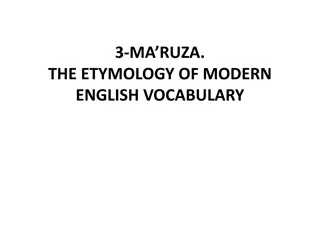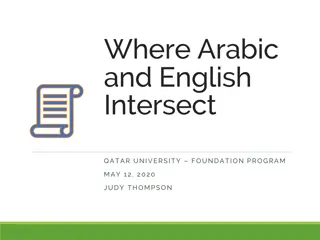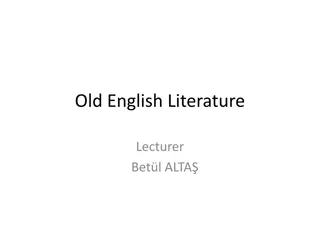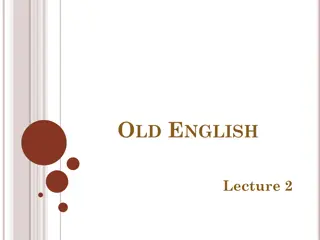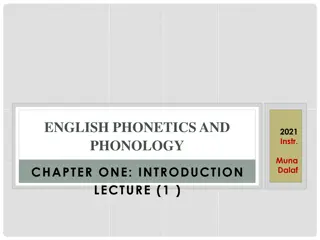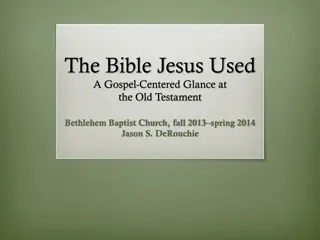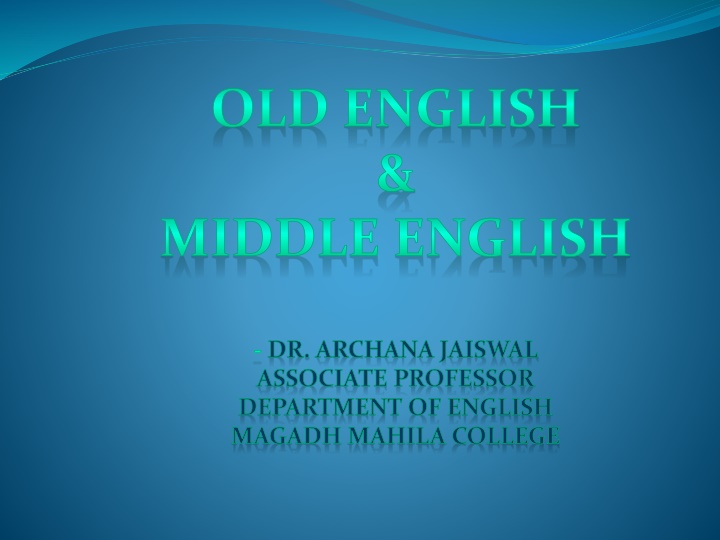
Old English and Middle English: Evolution and Characteristics
Explore the evolution and characteristics of Old English and Middle English periods, including dialects, grammatical changes, pronunciation, spelling, and more. Learn about the Anglo-Saxon influence and linguistic developments during these historical linguistics eras.
Download Presentation

Please find below an Image/Link to download the presentation.
The content on the website is provided AS IS for your information and personal use only. It may not be sold, licensed, or shared on other websites without obtaining consent from the author. If you encounter any issues during the download, it is possible that the publisher has removed the file from their server.
You are allowed to download the files provided on this website for personal or commercial use, subject to the condition that they are used lawfully. All files are the property of their respective owners.
The content on the website is provided AS IS for your information and personal use only. It may not be sold, licensed, or shared on other websites without obtaining consent from the author.
E N D
Presentation Transcript
OLD ENGLISH & MIDDLE ENGLISH - DR. ARCHANA JAISWAL ASSOCIATE PROFESSOR DEPARTMENT OF ENGLISH MAGADH MAHILA COLLEGE
Content Old English Period Old English Dialects Grammatical Changes in Old English Period. Middle English Period Middle English Dialects Grammatical Changes in Middle English Period
Old English Period The period extend from 450 AD to 1066 AD. Also called as Anglo-Saxon The Angles, the Saxons and the Jutes, had started filtering in England during the 5th Century. These tribes set up seven kingdoms called the Anglo- Saxon heptarchy. Anglo- Saxon gave Britain a new name England the Land of angles, and a new language, English the language of angles.
Old English Dialects Northumbrian in the North comprising the district between the Firth or Forth and the Humber river . Mercian, spoken between the Humber and the Thames. West Saxon, spoken in the region south of the Thames except in Kent and Surry. Kentish spoken in Kent and Surry.
Old English Grammar Old English had a very complicated grammatical system, with a number of different declensions of the noun. This period has often been described as the period of full inflections . Being highly inflected, Old English had a relatively free word order. In Old English we find four cases, Nominative, Accusative, Genitive, and the Dative case. In Old English there were two separate declensions of adjectives, the weak and the strong. In Old English, verbs had only two tense, the present and the preterit (like the past).
Old English Pronunciation Old English was more or less phonetic in character , its spelling representing its pronunciation fairly closely. The two major sound change on Old English were- mutation and gradation.
Old English Spelling The old English spelling was phonetic in character, each letter representing a sound and it contained no silent letters. Old English has seven vowels a,e,i,o,u,y (a+e) was the specialty of Old English. Old English remained a phonetic language without the discrepancy between spelling and pronunciation.
Old English Vocabulary This period is remarkable for its high degree of purity, with only a small amount of Latin loan words. The Old English word stock was enriched by Indo-European words, Celtic element, Latin influence and the Scandinavian influence.
Latin Vocabulary in Old English Latin words entered Old English in two phases: (1) during the Roman occupation. (2) through the early Christian missionaries
Middle English Middle English started with the Norman Conquest . A period of great change. English becomes official language of the law courts. More and more authors are writing in English. Decay of Inflectional Endings. French Influence on the Vocabulary of Middle English.
The causes of changes: (i) Norman Conquest (ii) Loss of a large part of Old English words. (iii) Add thousands of words from French and Latin.
Principal dialects of Middle English. i) Northern: - The Northern dialect extends as far south as the Humber. ii) East Midland & West Midland:-They together cover the area between the Humber and the Thames. iii) Southern :- Southern occupies the district south of the Thames.
Normans brought French in England. Thousands of French words added in English Vocabulary. French influence is much more direct and observable upon the vocabulary. French and English Peoples lived side by side a long time. French words poured into English with a momentum that continued until toward the end of the Middle English period.
Decay Of Inflection Endings There was a general reduction of inflectional endings of the noun. Case and Gender were altered in pronunciation. The loss of inflection also appeared in verbs. The vowels (a,o,u,e) in inflectional endings were transferred to a sound called indeterminate vowel.
The Noun In early Middle English only two methods of indicating the plural remained the s or es. The Pronoun i) The reduction of inflection was apparent in the demonstratives ii) The and that surviving through Middle English and use today.
The Verb i) Nearly a third of the old English strong verbs died out early in the Middle English. ii) Today more than half of the Old English strong verbs have disappeared completely from the standard Language. The use of he for Male and she for Female started in Middle English Period.


